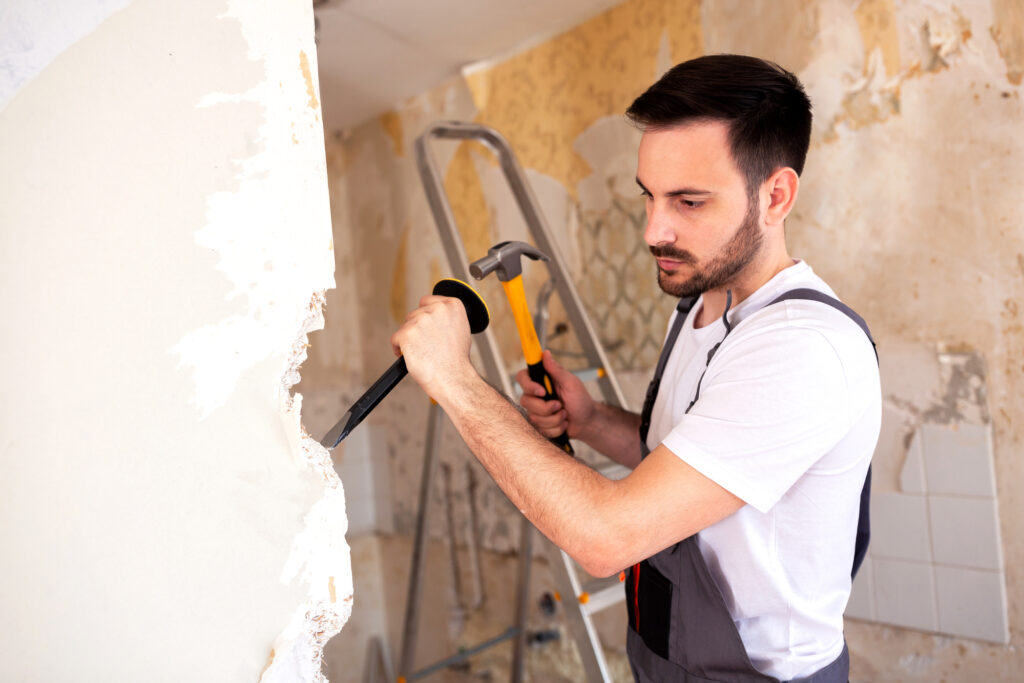Lloyd’s Remodeling & Cabinetry has been working on a renovation project where one of our first steps was to remove a wall. We have followed the steps outlined in this blog, and we are excited to show you the process. Stay tuned for future videos and blogs to see the final product of the renovation! Here is a video from our client that shows some highlights of the wall removal process so far:
Removing a wall in a home can be driven by various reasons, often aimed at optimizing space, improving functionality, or achieving a more open and modern layout. Homeowners may choose to remove walls to create larger living areas, enhance natural light, or accommodate changes in lifestyle or design preferences. However, the process of a wall removal should be approached with careful consideration and attention to safety. Ensuring the structural integrity of the building, identifying load-bearing walls, disconnecting utilities, and using proper tools and techniques are vital elements of a safe removal process.
Preparing to Remove a Wall
Preparing to remove a wall in your home is a crucial undertaking that demands caution and adherence to safety protocols. The following steps are how to effectively prepare for a wall removal:
The process begins by determining whether the wall is load-bearing or non-load-bearing. Load-bearing walls play a critical role in supporting the structure, and their removal requires additional considerations.
Check local building codes and regulations to ascertain whether a permit is required for the wall removal project. Compliance with these regulations is crucial to ensure safety and adherence to legal standards.
Professionals will know whether a project is feasible or not, and they will take all necessary precautions. Consulting professionals will also help prevent potential issues and ensure a smooth removal process.
Before beginning the actual removal of the wall, the surrounding area should be clear of furniture, decorations, and other items. This creates a safe and unobstructed workspace.
The electricity should be turned off in the removal area to prevent electrical hazards. Wearing appropriate safety gear, including safety glasses, gloves, and a dust mask, helps protect yourself and professionals during the removal process.
By addressing these key steps in preparation to remove a wall, you set the stage for a safe and well-executed wall removal project. This thorough approach ensures that you are informed about the structural implications, compliant with regulations, and equipped to maintain a secure environment throughout the removal process.

The Process of to Safely Remove a Wall
Here is how a wall removal works:
Removing Drywall and Exposing the Structure
The drywall currently covering the wall is removed, starting from the top and working down. The underlying structure is exposed by using tools such as a pry bar or reciprocating saw. Caution is taken to minimize damage to surrounding areas and ensure a clear view of the structural elements.
Supporting the Structure Temporarily, If Needed
If the wall being removed is a load-bearing wall, temporary support is installed to bear the load while the removal takes place. This may involve installing temporary supports such as adjustable steel columns or wall jacks.
Cutting and Removing Framing Elements
With the structure exposed and appropriately supported, tools are used to cut and remove framing elements. Caution should be exercised to avoid unnecessary damage to surrounding structures and ensure a controlled removal process. Specific techniques are used to cut through studs, plates, and other framing components.
Proper Disposal of Debris and Waste
Debris and waste should be disposed of responsibly by collecting it in designated containers or renting a dumpster for larger projects. Recyclable materials should be separated from non-recyclable ones, and local waste disposal regulations should be followed. This step ensures an organized and environmentally conscious approach to waste management.

Addressing Challenges and Unexpected Issues
As with most projects, unexpected challenges may arise that need to be addressed. Here are some common challenges that may occur during wall removal:
Hidden Utilities: Concealed electrical wiring, plumbing, or HVAC components within the wall can pose unexpected challenges. Accidentally damaging these utilities can lead to safety hazards and necessitate immediate attention.
Material Variations: The construction materials of the wall may vary from what was initially anticipated. Different materials, such as plaster or asbestos, may present unique challenges in terms of removal techniques and safety precautions.
Unforeseen Load-Bearing Issues: Despite initial assessments, unforeseen load-bearing issues may arise during removal. Discovering additional structural responsibilities may require immediate support and adjustments to the removal strategy.
Troubleshooting and Adapting to Unexpected Situations
In the face of unexpected situations, the overall removal plan should be reassessed. Effectively managing common challenges and adapting to unexpected situations requires a combination of experience, expertise, and a proactive approach. Prioritizing safety and seeking professional guidance when needed ensures a more controlled and successful wall removal process, even in the face of unforeseen complications. Llyod’s Remodeling & Cabinetry is one of the best in the business for removing walls safely and providing the remodel of your dreams!



CONTACT US: 801.797.0345